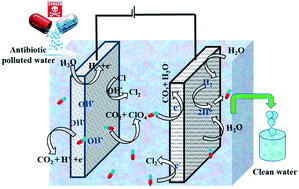Removal of antibiotics from aqueous solutions by electrocatalytic degradation
Abstract
The development of affordable and modular water/wastewater treatment technologies is highly desirable to counter the adverse effects of antibiotics. Electrochemical treatment, especially electrocatalysis, has a vast potential to degrade antibiotics due to its higher treatment efficiency, low power consumption, and flexible design. Correspondingly, the current review broadly discusses the present status and future trends regarding the electrocatalytic degradation of antibiotics. At the beginning, antibiotic distribution and the merits and demerits of conventional treatment technologies are briefly conveyed. Later, the electrocatalytic removal of antibiotics is discussed in detail with a special focus on catalyst type (e.g., metal-based and carbon-based nanomaterials), oxidative/reductive degradation pathways, and reaction mechanisms. A comprehensive assessment of removal efficiency, operational cost, environmental toxicity of nanomaterials, and residual by-product management has also been carried out. Overall, the feasibility of electrocatalysis technology for antibiotic removal and the critical strategies required for its development have been summarized to provide a roadmap for future research.

- This article is part of the themed collections: Environmental Science: Nano Recent Review Articles, Best Papers of 2021 from RSC’s Environmental Science journals and Best Papers 2021 - Environmental Science: Nano


 Please wait while we load your content...
Please wait while we load your content...